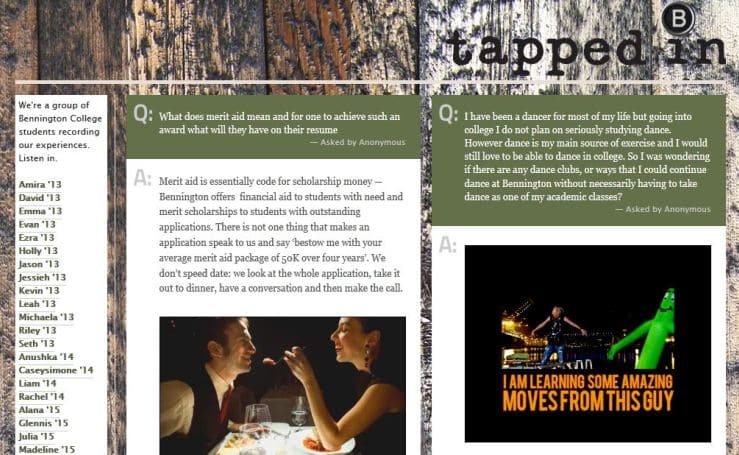Social networks: students love Tumblr
If Facebook and Twitter were kids in a classroom, they might be feeling a little crowded and less dominant these days given the new popularity of some of their classmates: Pinterest, Instagram, and Tumblr. These newer sites are captivating students the world over because of their highly visual interfaces – they are telling stories in seconds via photos and videos, and very compelling ones at that. In this article, we’ll look at the rapid ascent of Tumblr, and see how education institutions might best use it to connect with students.
Effortless sharing
This is what Tumblr does, according to Tumblr:
"Tumblr lets you effortlessly share anything. Post text, photos, quotes, links, music, and videos from your browser, phone, desktop, email or wherever you happen to be. You can customise everything, from colours to your theme's HTML."
As far as we can see, Tumblr is a powerful hybrid of Facebook, Twitter, Flickr, Instagram, and Pinterest – it combines the best features of these and actually acts as an aggregator of their content (e.g., Tumblr users can easily bring in posts from the other sites). Noelle Visani, on Higher Education Marketing, provides an excellent summary of what one can do on Tumblr (so excellent we are quoting liberally from her in this article – please check it out to see why). She says: “Just like Twitter, Tumblr works as a social media platform that allows you to:
- Update your status without being in your account, which means you can post from any other site or profile;
- Text your blog updates from any mobile phone;
- Use cross-blog tagging to curate content by tags, which is a great help in content discovery;
- Use a bookmarklet to share anything you come across while browsing the web."
She notes that it’s free to start and just like Wordpress (the popular blogging platform), "Tumblr enables you to:
- Customise your Tumblr site by creating your own custom theme;
- Be followed by other users;
- Tag your posts to make it easy for followers to see all your previous related posts;
- Easily add analytics tracking code to better understand your performance on the site;
- Allow users to comment (feature only available through Disqus).”
Show not tell
The adage “Show me, don’t tell me” is often used in fiction writing circles, but it is very appropriate here. 'Showing' via photos and video seems to be the way younger generations, including college-aged students, are preferring to communicate, and Tumblr responds beautifully to this. So rather than tell you more about what Tumblr can do, we’ll show you via these examples Ms Visani provides to three colleges that are using their Tumblr sites to powerful effect (complete with her descriptions of them):
- Florida International University has one of the most complete Tumblr sites, which includes a search bar on the homepage, a featured Twitter feed, campus snapshots, and helpful Q&A between students and the university’s administrators:

- The Department of Admissions at University of Chicago uses Tumblr to reply to questions about admissions or about the school in general:

- Bennington College’s Tumblr account also features a search bar on their homepage and student-faculty Q&A, while also featuring students’ campus experiences:

To our eye, the first two are the better examples, simply because they are so visual. As soon as you look at one picture, you want to check out the next. They also do a nice job of incorporating humour, which lends a great informal touch to the sites. Both sites suggest that students are having a fantastic time at the universities even as they also post academic and administrative information. And most importantly, they are communicating all these things lightning-fast; information is both addictive and digestible. You could spend an enjoyable minute on each site… or 30.
Who is using Tumblr?
The main target audiences for colleges and universities are current and prospective students, and Tumblr’s demographics skew very young: most are under 30. If you want to be where your students are, you may want to consider a Tumblr site. Tumblr is growing by leaps and bounds, and it is proving to be very engaging for students. According to Forbes:
“In November [Tumblr] shouldered its way into the top ten online destinations, edging out Microsoft’s Bing and drawing nearly 170 million visitors to its galaxy of user-created pages, according to the measurement firm Quantcast. Tumblr’s tens of millions of registered users create 120,000 new blogs every day, for a total of 86 million and counting, which drive some 18 billion page views per month.”
Here is another compelling stat about Tumblr:
“The amount of time that visitors spend on Tumblr averages around 2.4 hours a month, making it only second to Facebook in terms of user engagement.”
For more facts and figures on Tumblr, see our infographic below.
Should education institutions use Tumblr?
Search Engine Journalpoints out: “[On good Tumblr sites] content is very visual, eye-catching and quick to consume. If your product can fit into that mold, then Tumblr should be your next social media marketing channel to spread content and bring attention to your brand.” For more great tips on how to use Tumblr effectively, Social Media Examiner offers advice on using humour, showing off your brand's personality, and giving users an inside peek into your company or institution. Therefore, education institutions thinking about a Tumblr site should be guided by four considerations:
- Tumblr is not for long posts;
- It should be very visual, maximising the use of photo and video;
- It should “show rather than tell,” including a principle of letting students’ excitement about your brand tell your story;
- It’s about embracing flexibility and a sense of fun – it gives your brand breathing room.

















